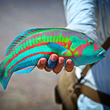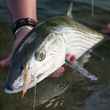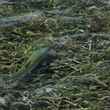While fishing the Lamar River in Yellowstone Park a few seasons back, I happened across a very fine cutthroat trout rising freely. I’d been attempting that day to photograph fish taking flies, so I called my partner over to have a go at this fish. After watching it rise a couple times, he waded into position and presented his fly. Promptly the trout rose, my friend tightened, and…nothing. Well, alright. Missed strikes constitute a part of fishing, even for competent anglers (which my friend surely is). Funny thing was, the fish never broke rhythm. A moment later he was back up again. My friend changed flies and cast once more. Up rose the fish, tight went the line, and again…nothing.
The fish kept rising. A third fly was presented. Another rise, another miss. My friend and I discussed the timing of his strike. He felt it was right on the money. Watching through the viewfinder of my camera as the shutter blazed away, I couldn’t be sure. A fourth change of fly brought yet another rise and another miss. Oh-for-four? Really?
The fish fed on. He took meals from the surface, in the film, and underneath. I could see it all. My friend tried other flies, finer tippet, and different casting angles. But as the presentations tallied up, the fish grew ever less responsive. A few more half-hearted rises and it was finally over, the cutthroat sinking into the depths. At the time I didn’t give the whole affair much thought. After all, this was cutthroat fishing—home province to any and all manner of strange happenings.
But while reviewing my photographs later that evening, I came across the shot shown above. My interest was immediately piqued. Quickly scanning the subsequent photos in the sequence, I realized that this fish never actually took my friend’s fly. Rather, it appears to have performed a balancing act of sorts. A balancing act, I believe, intended to determine the authenticity of a potential food item before actually ingesting it.
The two frames following the one above show the trout casually submerging, acting for all the world as if a fly disappearing from its lips were a common, everyday occurrence. My friend’s fly stays floating on the water, high and dry, pretty as you please. The fourth frame captures the line tightening as the hook was set (into thin air). Of course, this all took place in the blink of an eye and at distance. That’s why it was so easy to confuse the fly and leader riding on the lips of the trout with an actual take. Turns out that nothing was wrong with my friend’s timing or reflexes. Given that the fly never entered the fish’s mouth, he simply had no chance.
There’s no doubt that trout in heavily-fished waters often know when they’re being fished for. Their guard goes up. Their bodies tighten. They may continue to feed, but in doing so they exercise great caution (which is why a stealthy approach and a good first presentation count so much, even when fishing for cutthroats). This particular fish knew we were there, knew we represented danger, and was invoking a learned behavior to protect himself. (How it was that he was able to treat the natural flies differently than the artificials, I wish I knew.)
Numerous times I’ve sworn, as many readers will have, that a fish appearing to take to my fly actually did not take it, despite appearances to the contrary. Until this incident I could never be dead sure that such a thing happens. But now that I’ve got this picture, I know that it can and does. And the true significance of the image has finally come clear to me.
I mean, who doesn’t need a better excuse for a missed fish?





























Comments
Anonymous replied on Permalink
Boy, been there. Great shot and explanation. Lamar Valley holds great but tough fishing.
Thanks.
Bruce Carl replied on Permalink
I remember a time on the upper North Umpqua fishing pocket water high sticking with a Tenkara and standing on a boulder out in the middle of the water and I was perfectly positioned to flick up stream behind a boulder with slack water and get a perfectly slow dead drift back to me when a small rainbow came busting out of the water rolling over the fly and missing and the he came back up from the other side and missed again and then again from the other side … only missing by a fraction each time …. if I had been watching from shore I would have tried to set the hook the first time because I would have sworn that he had taken it but being right above the action I could see the misses...sometimes it's not you that is the one that's missing!
nick cef replied on Permalink
It's ironic that while questioning the timing of the hook set, the timing of the pictures were perfect. Pictures don't lie, and in this case definitely explain those missed hooks sets that we've probably all had numerous times. The question is, will we simply accept that as the justification next time it happens and just move on? Or will that fish just continue to haunt and frustrate us?
Larry Rand replied on Permalink
I had this happen to me last week while fishing for bluegills. In 25 hits, I landed six fish--but I don't think I missed 19 fish. There were some light hits I missed, but the rest were panfish that decided at the last second that a micropopper wasn't food. I was having too much fun to worry about it at the time.
Bob replied on Permalink
Atlantic Salmon are also known for this type of behaviour.
Andrew Wesner replied on Permalink
And how many have we flossed with good timing of a hook set. Fish that never really ate the fly...
Pages